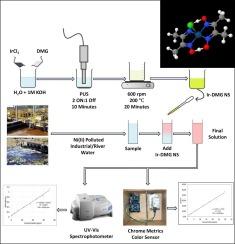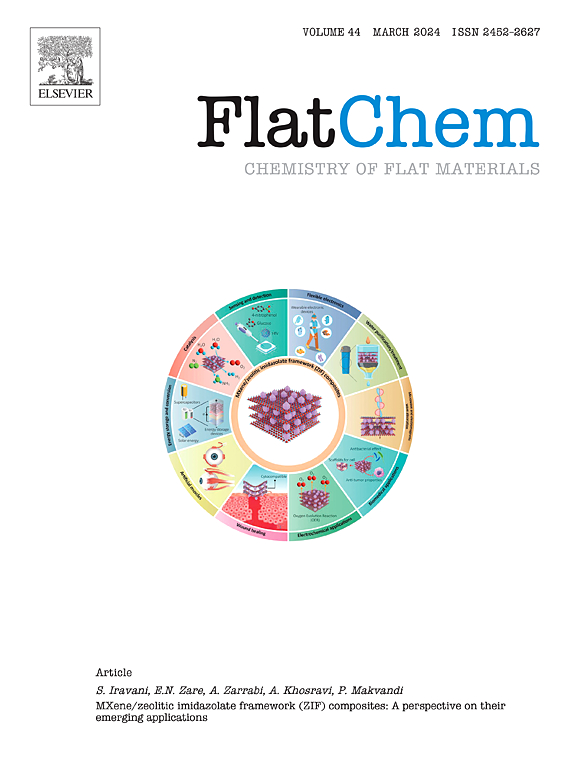Development of 2D Ir-DMG nanosheets as a colorimetric sensor probe for Ni (II) sensing and a highly sensitive, reliable, and portable colorimetric sensor device for environmental analysis
IF 5.9
3区 材料科学
Q2 CHEMISTRY, PHYSICAL
引用次数: 0
Abstract
The era of nanomaterials made a revolutionary change in colorimetric sensing with ultra-high sensitivity, improved reactivity, and enhanced photoactivity. The first-ever novel 2D metal–organic nanosheets were synthesized using IrCl3 and Dimethylglyoxime (DMG) by probe ultrasonication (PUS) followed by a solvothermal wet-chemical approach. This material has shown a rapid color change from yellow to crimson red with Ni (II) after the formation of complex. The UV–visible absorption spectra are the conventional methodology for colorimetric sensors and here, it was given a perfect linear relationship with an R2 of 0.99 and an LOD of 1.60 µM (0.1 ppm). The average calculated molar extinction coefficient for this system was 1889.30 M−1 cm−1. This is comparatively high absorptivity value. In addition, a novel Arduino-based colorimetric sensor device and corresponding software were developed under the name of “Chrom Metrics”. This Arduino device is unique since it can sense all wavelengths and the combined RGB delta E values. Therefore, it can provide more information/rationale for colorimetry than other devices/methods. The same Ir-DMG & Ni (II) system showed a perfect linear relationship with an R2 of 0.98 and a LOD of 0.85 µM (0.05 ppm) by the data obtained from this sensor device. Thus, this new device is easier and more accurate, highly efficient, rapid, highly selective, and sensitive.

开发二维 Ir-DMG 纳米片作为镍 (II) 检测的比色传感器探针,以及用于环境分析的高灵敏度、可靠和便携式比色传感器装置
纳米材料时代的到来使比色传感技术发生了革命性的变化,它具有超高的灵敏度、更好的反应活性和更强的光活性。利用 IrCl3 和二甲基乙二醛(DMG),通过探针超声(PUS)和溶热湿化学方法首次合成了新型二维金属有机纳米片。该材料与 Ni (II) 形成络合物后,颜色迅速从黄色变为深红色。紫外-可见吸收光谱是比色传感器的传统方法,在这里,它具有完美的线性关系,R2 为 0.99,LOD 为 1.60 µM(0.1 ppm)。该系统计算得出的摩尔消光系数平均值为 1889.30 M-1 cm-1。这是一个相对较高的吸收值。此外,还以 "Chrom Metrics "为名开发了一种基于 Arduino 的新型比色传感器设备和相应软件。这种 Arduino 设备非常独特,因为它可以感应所有波长和 RGB delta E 值的组合。因此,与其他设备/方法相比,它能为色度测量提供更多信息/依据。同样的 Ir-DMG & Ni (II) 系统显示出完美的线性关系,R2 为 0.98,从该传感器装置获得的数据显示,LOD 为 0.85 µM(0.05 ppm)。因此,这种新装置更加简便、准确、高效、快速、高选择性和灵敏。
本文章由计算机程序翻译,如有差异,请以英文原文为准。
求助全文
约1分钟内获得全文
求助全文
来源期刊

FlatChem
Multiple-
CiteScore
8.40
自引率
6.50%
发文量
104
审稿时长
26 days
期刊介绍:
FlatChem - Chemistry of Flat Materials, a new voice in the community, publishes original and significant, cutting-edge research related to the chemistry of graphene and related 2D & layered materials. The overall aim of the journal is to combine the chemistry and applications of these materials, where the submission of communications, full papers, and concepts should contain chemistry in a materials context, which can be both experimental and/or theoretical. In addition to original research articles, FlatChem also offers reviews, minireviews, highlights and perspectives on the future of this research area with the scientific leaders in fields related to Flat Materials. Topics of interest include, but are not limited to, the following: -Design, synthesis, applications and investigation of graphene, graphene related materials and other 2D & layered materials (for example Silicene, Germanene, Phosphorene, MXenes, Boron nitride, Transition metal dichalcogenides) -Characterization of these materials using all forms of spectroscopy and microscopy techniques -Chemical modification or functionalization and dispersion of these materials, as well as interactions with other materials -Exploring the surface chemistry of these materials for applications in: Sensors or detectors in electrochemical/Lab on a Chip devices, Composite materials, Membranes, Environment technology, Catalysis for energy storage and conversion (for example fuel cells, supercapacitors, batteries, hydrogen storage), Biomedical technology (drug delivery, biosensing, bioimaging)
 求助内容:
求助内容: 应助结果提醒方式:
应助结果提醒方式:


